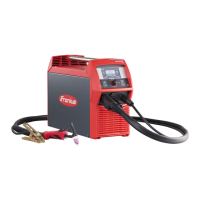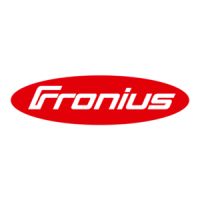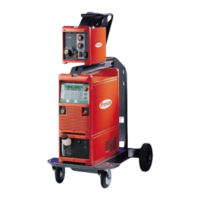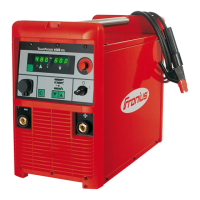What to do if Fronius Welding System tS3 error occurs?
- DDarren ClaySep 12, 2025
If the Fronius Welding System displays a tS3 error, it indicates overtemperature in the power source's secondary circuit. Allow the power source to cool down.
What to do if Fronius Welding System tS3 error occurs?
If the Fronius Welding System displays a tS3 error, it indicates overtemperature in the power source's secondary circuit. Allow the power source to cool down.
What to do if Fronius Welding System tSt error occurs?
If the Fronius Welding System displays a tSt error, it indicates overtemperature in the power source control circuit. Allow the power source to cool down.
| Input Voltage | 3 x 400 V |
|---|---|
| Output Current Range MMA | 10 - 400 A |
| Duty Cycle at 400 A | 60 % |
| Duty Cycle at 315 A | 100 % |
| Protection Class | IP 23 |
| No-load Voltage | 80 V |
| Welding Process | TIG, MMA |
| Rated Input Frequency | 50/60 Hz |
| Open Circuit Voltage | 80 V |
| Output Current Range TIG | 5 - 400 A |
| Welding Current Range | 5 A - 400 A |
| Cooling | Air-cooled |
Defines safety symbols like DANGER, WARNING, CAUTION, NOTE, and IMPORTANT.
Outlines general safety standards, operator obligations, and device handling requirements.
Specifies the intended purpose of the device and lists improper uses.
Defines responsibilities for personnel operating the welding device, including qualifications and training.
Lists risks like sparks, arc radiation, EMF, electrocution, noise, fumes, and required protective clothing.
Warns about welding fumes causing health issues and details ventilation and mask requirements.
Details risks from flying sparks, fire hazards, and necessary precautions like fire extinguishers.
Explains risks of electric shock from mains/welding current and precautions for cables and connections.
Lists measures to avoid EMC issues and discusses potential health risks from electromagnetic fields.
Details safety checks during operation, handling hot parts, and risks associated with coolant.
Covers shielding gas cylinder safety, installation stability, and workplace safety measures.
Emphasizes operating only with functional safety devices, avoiding bypass, and checking for damage.
Stresses using original parts, avoiding modifications, and proper grounding screw usage.
Describes the power sources as digitized, microprocessor-controlled inverters with modular design and flexible add-ons.
Emphasizes that warning notices on the device must not be removed or painted over.
Illustrates and lists power sources, cooling units, trolleys, torches, remote controls, and cables.
Identifies and describes components like digital displays, HOLD indicator, and their functions for MagicWave.
Explains indicators (voltage, unit), process buttons, mode buttons, and parameter selection buttons.
Identifies and describes components like digital displays, HOLD indicator, and their functions for TransTig.
Explains voltage indicator, unit indicators, mode buttons, parameter selection, and gas test button.
Details front and rear connections for MagicWave 1700/2200, including torch, LocalNet, grounding, gas, and mains.
Details front and rear connections for MagicWave 2500/3000, including grounding, LocalNet, torch, gas, and mains.
Emphasizes that all work must be done by trained personnel and highlights risks of incorrect operation or toppling.
Warns about severe injury/damage from electric shock during installation and emphasizes unplugging the device.
Warns about injury/damage from toppling gas cylinders and stresses secure mounting and manufacturer's instructions.
Warns about injury/damage from incorrect operation and requirement to read all instructions.
Warns about injury/damage from incorrect operation and electric shock if the power source is connected.
Explains HF ignition activation, indicator, benefits, and the procedure for placing the nozzle and actuating the trigger.
Warns about injury/damage from incorrect operation and electric shock during installation.
Warns about injury/damage from incorrect work and electric shock, emphasizing safety rules and device disconnection.
Details service codes for overtemperature in primary/secondary circuits and control circuits.
Addresses issues where indicators are not lit, including mains lead, plug, or socket faults.
Covers issues with no welding current, including overload, thermostatic cut-out, fan faults, and grounding connection errors.
Reiterates safety warnings for work on the device, including electric shock and ground connection integrity.
Lists mains voltage, frequency, fuse protection, current ranges, open circuit voltage, and dimensions.
Provides technical specifications for MW 2500/3000, including mains voltage, current ranges, and weight.
Lists technical data for MW 2500/3000 MV, covering mains voltage, frequency, and continuous power.
Details technical specifications for MW 4000/5000, including welding current ranges and insulation class.
Covers technical data for MW 4000/5000 MV, including mains voltage tolerance and EMC emission class.
Continues technical data for MW 4000/5000 MV, detailing dimensions and weight.
Lists technical specifications for TT 2200, including mains voltage, current ranges, and working voltage.
Provides technical data for TT 2500/3000, including mains connection impedance and primary continuous power.
Details technical specifications for TT 2500/3000 MV, including mains voltage tolerance and welding current at specific duty cycles.
Lists technical data for TT 4000/5000, including current ranges and degree of protection.
Covers technical data for TT 4000/5000 MV, including mains voltage tolerance and insulation class.












